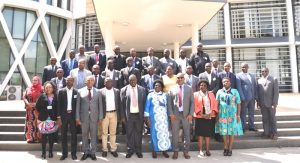East African countries may change common external tariffs

Participants who met in Arusha on Thursday and Friday, discussed the key highlights of the proposed 2019/2o20 EAC Secretariat budget.
August 31, 2018—There are strong indications that the East African Community (EAC) Partner States want to further shield regional manufacturing and industry by raising import duties on a selection of items in the near future with textiles and finished leather products being the leading targets.
During a recently ended two-day Pre-Budget Conference for the EAC Organs and Institutions for the Financial Year 2019/2020 at the EAC Headquarters in Arusha, Eng. Steven Mlote, said a review of the EAC Common Tariff (CET) was underway.
Mid last year, Garth Frazier, Associate Professor of Business Economics at the University of Toronto said, ‘It has become urgent to evaluate the impact of the tariff regime in relation to member states’ development objectives, for example, export development, industrial competitiveness, employment and poverty reduction.”
At present the three tariff bands are zero percent for raw materials and capital goods; 10 pc for intermediate goods and 25 pc for finished items. Thirty percent is imposed on items regional governments agree are necessary but labeled ‘sensitive’ due to direct impact on local producers. Imported sugar is the most common item in this category.
He said “The smaller, less industrialised and landlocked countries in the region – Rwanda and Uganda – will need to negotiate the most effective tariff regime from their perspective (as their industries encounter higher transport costs for imported inputs and exports on the one hand, and enjoy natural protection for domestic output markets on the other). Moreover, the mis-classification of imported intermediate inputs as final goods in practice may have adversely impacted industrial competitiveness in these countries– more so than in Kenya and Tanzania, due to the additional markup for transportation costs of imported inputs.”
The conference was attended by Members of the General Purpose Committee of the East African Legislative Assembly (EALA), Permanent and Principal Secretaries, senior officials from Partner States, Heads of EAC Organs and Institutions, and staff from the Secretariat.
All EAC countries are obliged to apply CET under the terms of the EAC protocols. However the dynamics of regional and international trade have considerably changed since 2004 when CET was first enforced, notably the flood of Chinese-made goods and increased competition among regional manufacturers has created tensions over Rules of Origin. Basically, these rules constitute whether a product can be considered local or foreign depending on the sources of inputs and are often a point of contention among EAC member states.
According to a release, Mlote, the Deputy Secretary General in charge of Planning and Infrastructure, who represented the Secretary General, said to promote the region’s textile and leather industries, the CET review will involve setting rates that will provide incentives for value addition, as well as cushion the industry from dumping.
Partner States have also taken measures to promote the textile and leather sectors through enforcement of conformity with Sanitary and Phytosanitary (SPS) requirements, particularly for the used under-garments and synthetic shoes.

 African Heads of state head to South Korea next week for Summit talks
African Heads of state head to South Korea next week for Summit talks
 Trading leads as main source of income for Ugandans
Trading leads as main source of income for Ugandans
 New leadership for bankers’ umbrella as total assets top $12 billion
New leadership for bankers’ umbrella as total assets top $12 billion
 Brussels Airlines to announce Nairobi service
Brussels Airlines to announce Nairobi service
 SITA promises enhanced travel experience after Materna acquisition
SITA promises enhanced travel experience after Materna acquisition
 Saudia’s 105 aircraft order stretches A320neo lead over rival Max
Saudia’s 105 aircraft order stretches A320neo lead over rival Max
